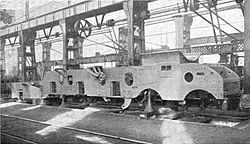
A bogie is a chassis or framework that carries a wheelset, attached to a vehicle—a modular subassembly of wheels and axles. Bogies take various forms in various modes of transport. A bogie may remain normally attached or be quickly detachable. It may include a suspension component within it, or be solid and in turn be suspended ; it may be mounted on a swivel, as traditionally on a railway carriage or locomotive, additionally jointed and sprung, or held in place by other means.
Rail transport terms are a form of technical terminology applied to railways. Although many terms are uniform across different nations and companies, they are by no means universal, with differences often originating from parallel development of rail transport systems in different parts of the world, and in the national origins of the engineers and managers who built the inaugural rail infrastructure. An example is the term railroad, used in North America, and railway, generally used in English-speaking countries outside North America and by the International Union of Railways. In English-speaking countries outside the United Kingdom, a mixture of US and UK terms may exist.

An articulated locomotive is a steam locomotive with one or more engine units that can move independently of the main frame. Articulation allows the operation of locomotives that would otherwise be too large to negotiate a railroad's curves, whether mainlines or special lines with extreme curvature such as logging, industrial, or mountain railways.
A footplate provides the structure on which a locomotive driver and fireman stand in the cab to operate a British or continental European steam locomotive. It comprises a large metal plate that rests on top of the locomotive frame, usually it is covered with wooden floorboards. It takes up the full width of the locomotive cab, and in depth it extends from the front of the cab to the coal bunker on the tender. The cab and other superstructure elements are in turn mounted on it. On some locomotives, the footplate is extended beyond the front of the cab to form a walkway around the boiler – usually referred to as the "running board" or "foot board" – to facilitate inspection and maintenance.
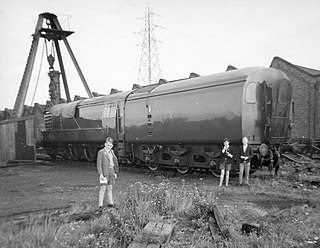
GT3 was a prototype mainline gas turbine locomotive built in 1961 by English Electric at its Vulcan Foundry in Newton-le-Willows to investigate the use of its gas turbines in rail traction applications. It followed 18000 and 18100 as gas turbines 1 and 2. It was designed by English Electric engineer J. O. P. Hughes in a project that started in the early 1950s. Externally it resembled a steam tender locomotive, but the tender carried kerosene fuel. The designer said the traditional chassis and mechanical transmission avoided complications with relatively untried technologies for bogies and electrical transmission.

The X class is a class of diesel locomotives built by English Electric for the Tasmanian Government Railways between 1950 and 1952. They were the first class of diesel locomotive to enter mainline service on a Government-owned railway in Australia.
B-B and Bo-Bo are the Association of American Railroads (AAR) and British classifications of wheel arrangement for railway locomotives with four axles in two individual bogies. They are equivalent to the B′B′ and Bo′Bo′ classifications in the UIC system. The arrangement of two, two-axled, bogies is a common wheel arrangement for modern electric and diesel locomotives.

Under the Whyte notation for the classification of steam locomotives by wheel arrangement, a 4-6-2+2-6-4 is a Garratt or Union Garratt articulated locomotive using a pair of 4-6-2 engine units back to back, with the boiler and cab suspended between them. The 4-6-2 wheel arrangement of each engine unit has four leading wheels on two axles, usually in a leading bogie, six powered and coupled driving wheels on three axles, and two trailing wheels on one axle, usually in a trailing truck.
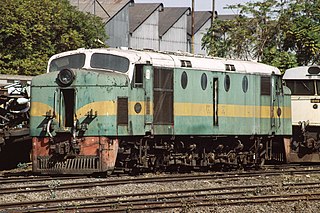
Rhodesia Railways class DE2 are a type of diesel locomotive built for operations on Rhodesia Railways in the 1950s. The first entered service on 22 June 1955.
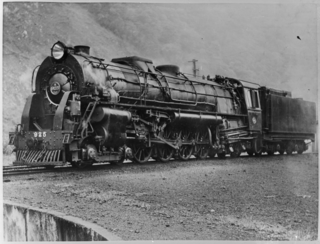
The NZR K class of 1932 was a class of mixed traffic 4-8-4 steam locomotives built by the New Zealand Railways Department (NZR) that operated on New Zealand's railway network. The locomotives were developed following the failure of the G class Garratt locomotives. The class should not be confused with the much earlier K class of 1877-78, the first American-built engines to arrive in New Zealand.

The Victorian Railways E class was a class of electric locomotive that ran on the Victorian Railways (VR) from 1923 until 1984. Introduced shortly after the electrification of the suburban rail system in Melbourne, Australia, and based on the same electrical and traction equipment as Melbourne's early suburban electric multiple unit fleet, they provided power for suburban goods services and shunting for six decades.

The New South Wales AD60 class were Beyer-Garratt patent articulated four-cylinder, simple, non-condensing, coal-fired superheated, 4-8-4+4-8-4 heavy goods steam locomotives built by Beyer, Peacock & Company for the New South Wales Government Railways in Australia.
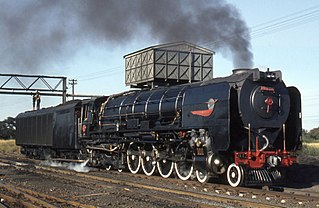
The South African Railways Class 25 4-8-4 of 1953 was a condensing steam locomotive.

The South African Railways Class 21 2-10-4 of 1937 was a class of steam locomotives used in South Africa.

The South African Railways Class FC 2-6-2+2-6-2 of 1925 was an articulated steam locomotive.
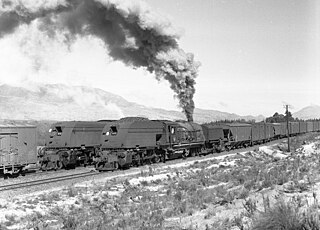
The South African Railways Class GEA 4-8-2+2-8-4 of 1946 was an articulated steam locomotive.

The South African Railways Class GM 4-8-2+2-8-4 of 1938 was an articulated steam locomotive.

Rigid-framed electric locomotives were some of the first generations of electric locomotive design. When these began the traction motors of these early locomotives, particularly with AC motors, were too large and heavy to be mounted directly to the axles and so were carried on the frame. One of the initial simplest wheel arrangements for a mainline electric locomotive, from around 1900, was the 1′C1′ arrangement, in UIC classification.
The 1001 class were a class of ten diesel-electric locomotive built by English Electric and Vulcan Foundry in 1955 for Nigerian Railways along with fourteen for the Gold Coast Railways as their 1000 class. Construction and layout was a very similar to the earlier NZR De class.
